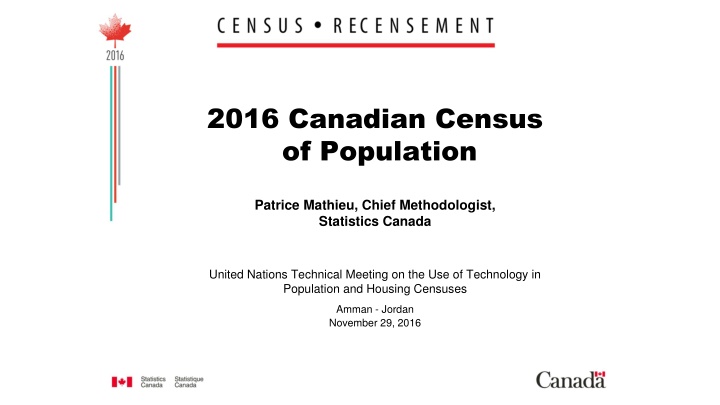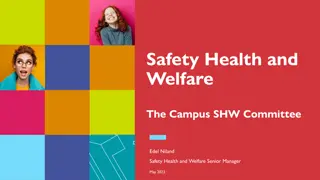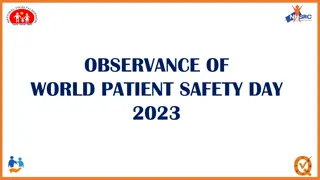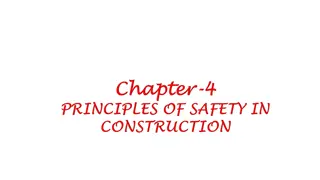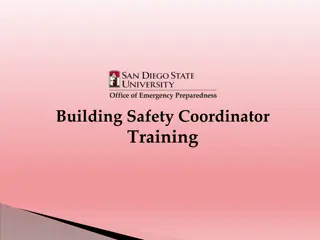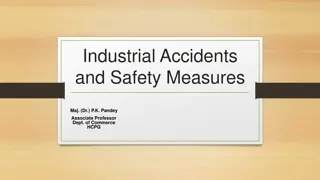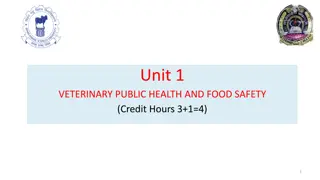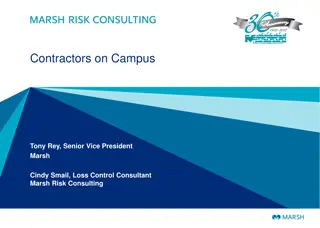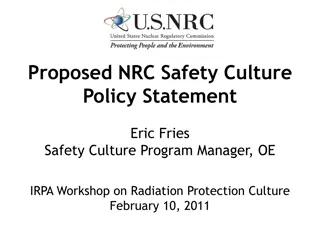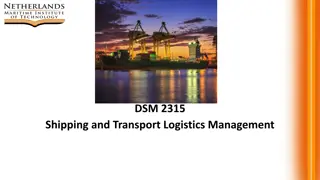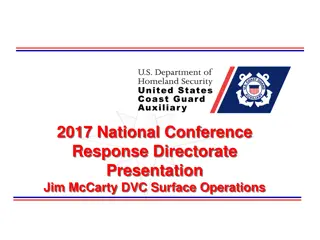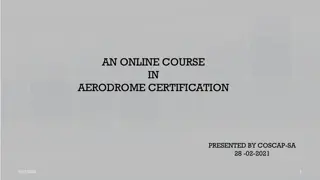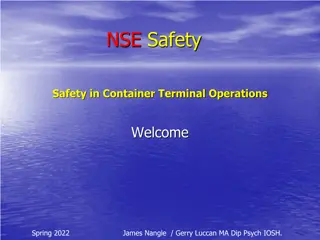Ensuring Health and Safety in Your Home
A healthy home is more than just a shelter; it must protect against various environmental hazards like poor ventilation, carbon monoxide poisoning, and cigarette smoke. Learn about signs of poor ventilation, the dangers of carbon monoxide, and the health risks associated with smoking and second-hand smoke exposure.
Download Presentation

Please find below an Image/Link to download the presentation.
The content on the website is provided AS IS for your information and personal use only. It may not be sold, licensed, or shared on other websites without obtaining consent from the author.If you encounter any issues during the download, it is possible that the publisher has removed the file from their server.
You are allowed to download the files provided on this website for personal or commercial use, subject to the condition that they are used lawfully. All files are the property of their respective owners.
The content on the website is provided AS IS for your information and personal use only. It may not be sold, licensed, or shared on other websites without obtaining consent from the author.
E N D
Presentation Transcript
2016 Canadian Census of Population Patrice Mathieu, Chief Methodologist, Statistics Canada United Nations Technical Meeting on the Use of Technology in Population and Housing Censuses Amman - Jordan November 29, 2016
Agenda The 2016 Canadian Census at a glance Key operations Wave methodology Preliminary collection results How did we do it? Wave Model for planning, monitoring and forecasting Multi-mode collection Wave Methodology Support systems and infrastructure New corporate collection systems Towards 2021 and 2026 2
The 2016 Canadian Census at a glance Census Day: May 10th, 2016 Multi-mode collection: Self-Response (May 2 to July 31, mostly in May) Electronic and paper questionnaires Non-Response Follow-up NRFU (June and July) Field enumerators complete paper questionnaires with respondents Support units or Census Help Line operators complete electronic questionnaires from call centres Failed-Edit Follow-up (During NRFU) Phone follow-up for incomplete questionnaires or coverage issues (sample) Special enumeration procedures for collective dwellings, aboriginal communities (reserves), and remote areas 3
The Wave Methodology Approach to remind Canadians to fill out their census form, at specific times throughout the collection period Increases Self-Response while encouraging households to respond by Internet Concept of the Wave Methodology: Wave 1: Mail out an Invitation Letter instead of a questionnaire. No immediate option for paper response but the letter provides an effective method to request a paper questionnaire (about 1 million requests in 2016 (8% of the dwellings)). Availability of an automated system to request a paper questionnaire was essential Wave 2: As the returns from Wave 1 starts to decline, mail out a reminder letter Wave 3: As the returns from Wave 2 starts to decline, mail out a paper questionnaire Wave 4: As the returns from Wave 3 starts to decline, start NRFU 4 Aligned public communication messages
2016 Census Wave Methodology Wave 1 Wave 2 Wave 3 Wave 4 NRFU + Mail-out Quest. NR NR NR Reminder (82%) Letter letter & letter Automated calls List/Leave Thank you / Reminder Adcard NR NRFU (May 20th) (16%) Quest. Canvasser (2%) Interview May 2nd May 11-13th May 19-26th June 1st Census Day, May 10th 5
Collection Response Rates - Highlights 2011 Census 2016 Census Collection Rate Actual Planned Actual Census Collection rate 98.1% 98% 98.4% Internet Paper Self-Response NRFU Workload at start of NRFU 53.8% 31.3% 85.2% 12.9% 4.8 M 65% 20% 85% 13% 4.5M 68.3% 20.5% 88.8% 9.7% 3.7 M 6 Source: MCS of August 4, 2016 occupied private dwellings
Response Rates by Collection Method Response Mode Self-Response Interview Non- response Collection method Total NRFU Help Line Mail Internet Total Total Support Units Field Mail-Out 12.7% 76.2% 89.0% 1.1% 7.4% 0.9% 9.4% 1.6% 100.0% List-leave / Seasonal 64.1% 23.6% 87.7% 0.5% 9.3% 1.3% 11.1% 1.2% 100.0% Subtotal 20.5% 68.3% 88.8% 1.0% 7.7% 1.0% 9.7% 1.5% 100.0% Canvasser/reserves N/A 0.2% 0.2% 0.0% 92.1% 0.0% 92.1% 7.7% 100.0% Total 20.3% 67.6% 87.9% 1.0% 8.5% 1.0% 10.5% 1.6% 100.0% 7 Source: MCS of August 4, 2016 private occupied dwellings
Internet responses by device category Number of Dwellings Device category Response Rate Relative Rate Desktop / Laptop 53.4% 78.2% 7,488,580 Tablet Smartphone Desktop/Laptop (Touch-Screen) Gaming Devices TV Unidentified 8.8% 5.1% 12.9% 7.5% 1,236,616 714,354 1.0% 1.4% 134,456 0.0% 0.0% 0.0% 68.3% 0.0% 0.0% 0.0% 100.0% 1,110 8 1,974 9,577,098 Total 8
Wave 1 Received on May 2 Internet and Mail daily return rate Wave 2 Received between May 11-16 May 19-26 Wave 3 1,400,000 Voice Broadcast On May 30-31 Received between Census Day On May 10 9.0% 1,200,000 8.0% 1,000,000 7.0% 6.0% 800,000 5.0% Self-Response Impact of Wave 2 Internet 600,000 4.0% Impact of Wave 3 Mail Impact of Wave 4 / Voice Broadcast 3.0% 400,000 2.0% 200,000 1.0% 0 0.0% 5/1/2016 5/2/2016 5/3/2016 5/4/2016 5/5/2016 5/6/2016 5/7/2016 5/8/2016 5/9/2016 5/10/2016 5/11/2016 5/12/2016 5/13/2016 5/14/2016 5/15/2016 5/16/2016 5/17/2016 5/18/2016 5/19/2016 5/20/2016 5/21/2016 5/22/2016 5/23/2016 5/24/2016 5/25/2016 5/26/2016 5/27/2016 5/28/2016 5/29/2016 5/30/2016 5/31/2016 6/1/2016 6/2/2016 6/3/2016 6/4/2016 6/5/2016 6/6/2016 6/7/2016 6/8/2016 6/9/2016 6/10/2016 6/11/2016 6/12/2016 6/13/2016 6/14/2016 6/15/2016
Wave 1 Received on May 2 Internet and Mail cumulative return rate 15,000,000 100.0% 14,000,000 Wave 3 Wave 2 Received between May 19-26 Received between May 11-16 13,000,000 90.0% 12,000,000 80.0% 11,000,000 Census Day On May 10 10,000,000 70.0% 9,000,000 60.0% 8,000,000 Self-Response cumulative Voice Broadcast On May 30-31 50.0% 7,000,000 Internet Cumulative Mail Cumulative 6,000,000 40.0% Number of occupied dwellings 5,000,000 30.0% 4,000,000 3,000,000 20.0% 2,000,000 10.0% 1,000,000 0 0.0% 5/1/2016 5/3/2016 5/5/2016 5/7/2016 5/9/2016 5/11/2016 5/13/2016 5/15/2016 5/17/2016 5/19/2016 5/21/2016 5/23/2016 5/25/2016 5/27/2016 5/29/2016 5/31/2016 6/2/2016 6/4/2016 6/6/2016 6/8/2016 6/10/2016 6/12/2016 6/14/2016 6/16/2016 6/18/2016 6/20/2016 6/22/2016 6/24/2016 6/26/2016 6/28/2016 6/30/2016 7/2/2016 7/4/2016 7/6/2016 7/8/2016 7/10/2016 7/12/2016 7/14/2016 7/16/2016 7/18/2016 7/20/2016 7/22/2016 7/24/2016 7/26/2016 7/28/2016 7/30/2016 8/1/2016 8/3/2016
How did we do it? Wave Model - Static Master control system (MCS) Wave approach A process for on-demand Wave 2 letters A process for on-demand Wave 3 questionnaire packages An automated system to enable Canadians to call for a paper questionnaire Corporate collection systems Wave Model - Dynamic 11
Wave Model Needed tools for planning, monitoring and forecasting purposes Two types of models used in 2016: static & dynamic Static: Main uses provided the planned daily and cumulative volumetrics for printing, collection and processing Predicted responses by day and by channel, given assumptions before collection started Started with Address Register projections of dwelling counts on Census day, then daily return estimates based on daily returns from Census 2011, Census Content Test data and guestimates 12
Master Control System (MCS) Central system that integrated information from all collection and processing systems. List of all dwellings in Canada to which a questionnaire is mailed or dropped off Each record given a unique frame-id and a secure access code Used to monitor the status of each dwelling throughout collection (Canada Post, internet submissions, Data Operations Centre and NRFU) and processing Provided almost real-time updates 13
Wave Methodology Material Wave 1 & 2 letters: Self-Mailers Needed a cost effective way to mail-out a planned 13.3M Wave 1 letters and 8.4M Wave 2 reminder letters (on demand) with variable imaged addresses and secure access codes. Wave 3 and QRS: Questionnaires packages About 4M Questionnaire packages prepared in advance with generic barcodes and secure access codes printed on questionnaires Generic barcode showing through envelope window As questionnaires are required, MCS transmits the address information and dwelling identifier to Canada Post. Canada Post prints address and true barcode on envelope, then scan the two barcodes to create the linkage 14 Linkage file sent back to MCS
Waves 1 and 2 self-mailers 2011 Canadian Census
Wave 3 and QRS questionnaire packages Read generic barcode through envelope window Linked 123 ABC STREET ANYTOWN, ANYPROV Read true barcode Canada Post prints on questionnaire envelope 16
Adopting Corporate Collection Systems for the Census From 2006 NRFU System located in every Local Census Offices (LCO) NRFU System linked to the Master Control System, used by the Field Operation Supervisors located in the LCO Assignment Lists, Notification Lists, NRFU Control Forms and other forms faxed or shipped by courier (to/from Field Operation Supervisors, Crew Leaders and Enumerators) to 2011 Field Management System (FMS) Controlled-access web portal for field enumerators and supervisors Linked to the Master Control System, and used by all levels of field staff (assignment lists, pay claims, tracking shipments, birthing dwellings, notifications, etc. Provided field staff and managers with timely information to manage workloads and control costs to 2016 17
Adopting Corporate Collection Systems for the Census Statistics Canada adopted a Corporate Business Architecture which calls for IT solutions and business processes to be developed for corporate use rather than for individual program specific requirements Allows for more robust solutions More rigorous risk mitigation strategy Allows economies of scale for the department For the 2016 Census: New Integrated Collection and Operation System (ICOS) Single multi-mode, multi-site, generic and integrated collection environment Common collection platform for all programs and surveys Unique portal for all collection users (respondents, interviewers, managers, etc.) In particular: Common internet application (eQ) to replace the census-specific application used since 2006 Collection Management Portal (CMP) to replace the Field Management System used in 2011 18
Collection Management Portal (CMP) CMP for Field Enumerators: Obtain and update non-response follow-up assignments (record attempts and outcome codes) Timely updates on cases resolved from other sources Submit daily claims for hourly pay and travel expenses Record tracking information for questionnaires shipped CMP for Crew Leaders (Supervisors) Create assignment lists Review daily productivity and approve pay claims (productivity/travel claims linked to productivity) Monitor Key Indicator Reports Perform Quality Control Record tracking information for questionnaires shipped CMP for Managers Daily metrics obtained for non-response follow-up status to monitor progress Provides basis for monitoring costs 19
Wave Model - Dynamic Dynamic predictive microsimulation model to optimize use of human and financial resources in pursuit of response objectives Updated weekly for parameters to reflect current collection operations, the model projected the end of collection by region based on a number of parameters such as: Self-response levels and remaining number of cases to be resolved; Productivity of enumerators; Projected attrition of enumerators; Hours worked per day by enumerator by area and by collection supports units Model was flexible enough to explore different scenarios Estimated the number of work hours to be added in any given region/area to complete collection operations by the end of July at the targeted response level. Forecasted collection cost until the end of collection to see if available budget would be sufficient 20
Towards 2021 and 2026 Ongoing research on increased use of administrative data sources To replace direct response from respondents To replace NRFU in some cases possibly integrated in non-response management strategy To support other field activities, such as determining the occupancy status of the dwellings Expand mail-out areas Use of geospatial technologies, in particular in list/leave areas and to optimize Field Enumerator workload allocation Reduce the amount of paper we use Eliminate drop-off of paper questionnaires in list/leave areas? Paper questionnaires completed by Field Staff - Use of handled devices? Understand who are the more than 1 million people who used the QRS Improve systems? CMP, EQ, others? 21
Thank you! Pour plus d information, veuillez contacter: For more information, please contact: patrice.mathieu@statcan.gc.ca 22
